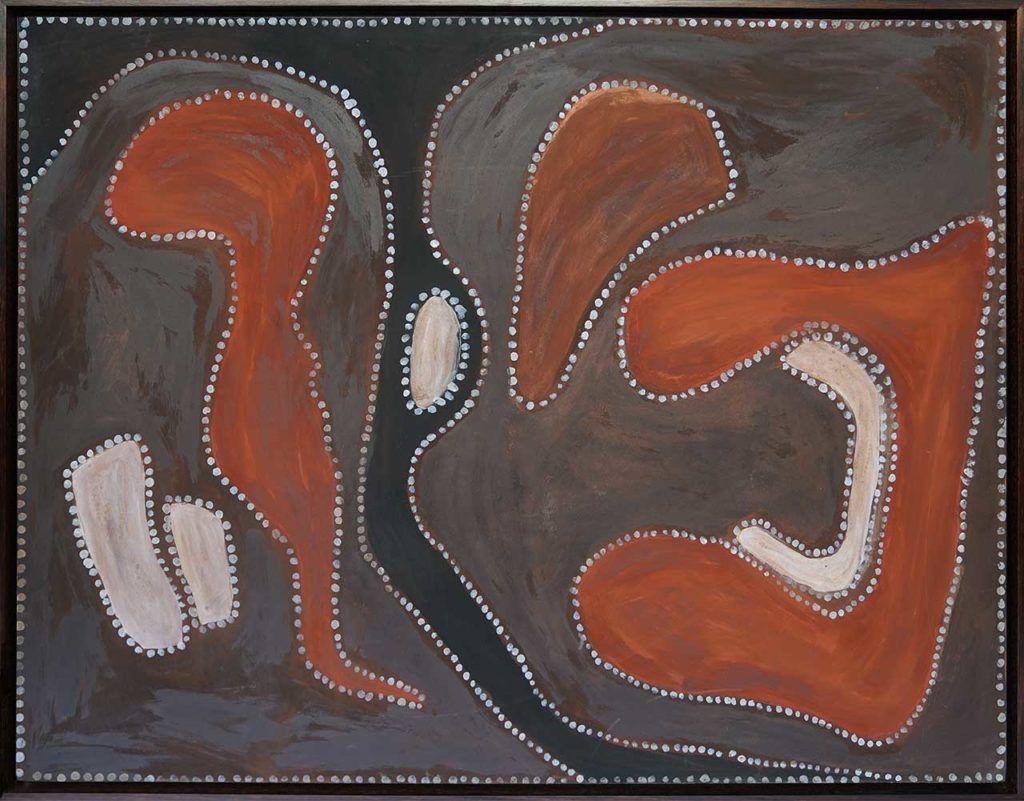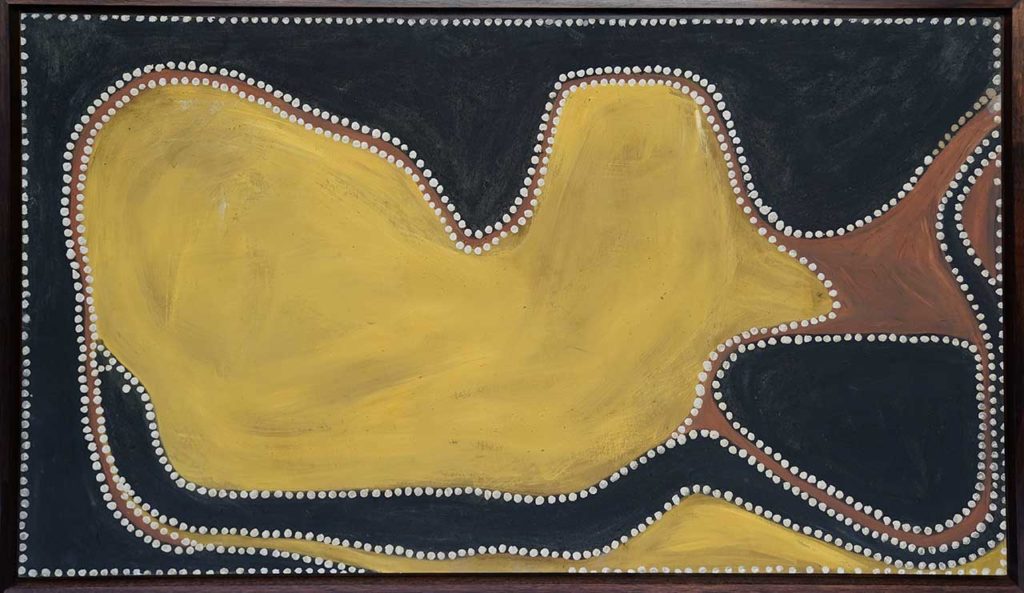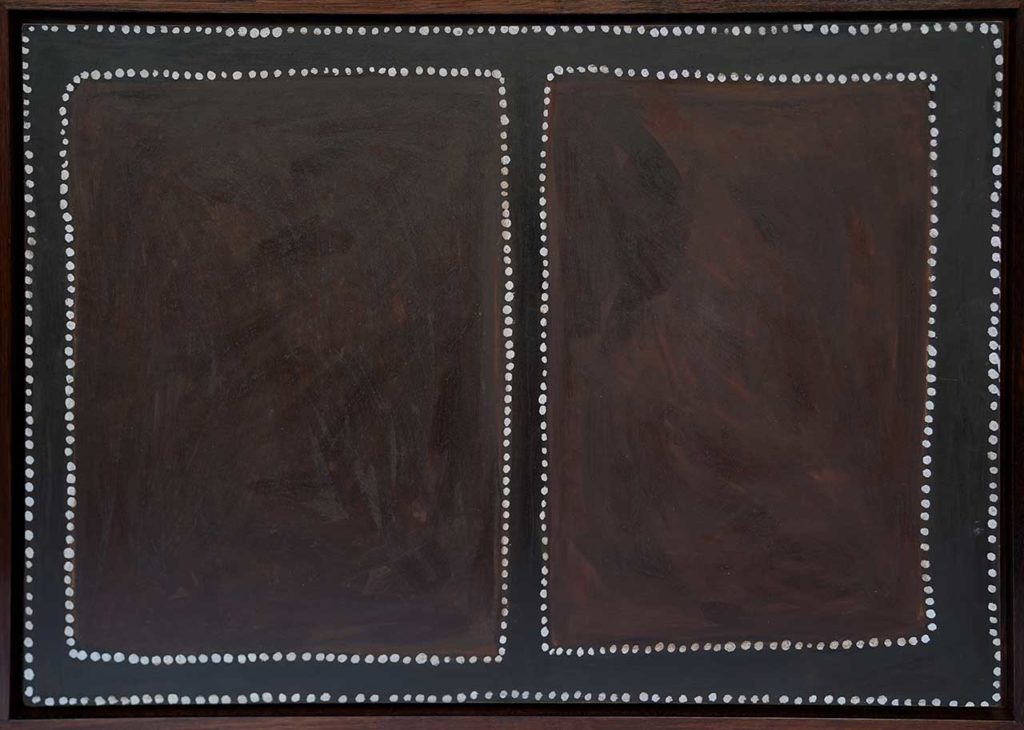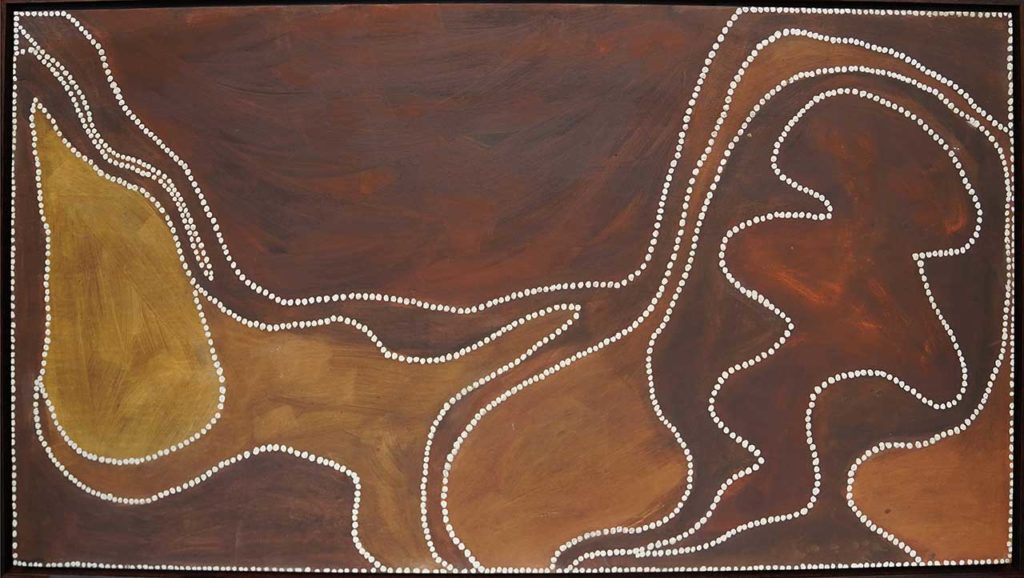Rover Thomas
Why is Aboriginal artist Rover Thomas famous?
Along with Emily Kame Kngwarreye, Rover Thomas is one of the most successful Australian artists in the national and international art markets.
When did Rover Thomas paint?
Rover Thomas started painting on boards in the early 1980s. He then turned to ochre on canvas. He was one of the founders of what was became known as the East Kimberley School.
What does Rover Thomas paint?
At first glance, his art looks like modernist abstraction and that is part of his international appeal. The paintings are like storytelling maps of places within his traditional country in the Kimberley.
What region is Rover Thomas from?
Rover Thomas was born sometime around 1926 at Gunawaggi near Well 33 on the Canning Stock Route. This is a place in the Great Sandy Desert of Western Australia.
Medium
Natural locally sourced ochre pigment on canvas.
Collector Status
Rover Thomas is recognised as one of the most significant Aboriginal artists of the late 20th century.
View Available Works: Rover Thomas Collection
Receive Newsletter Updates: Subscribe
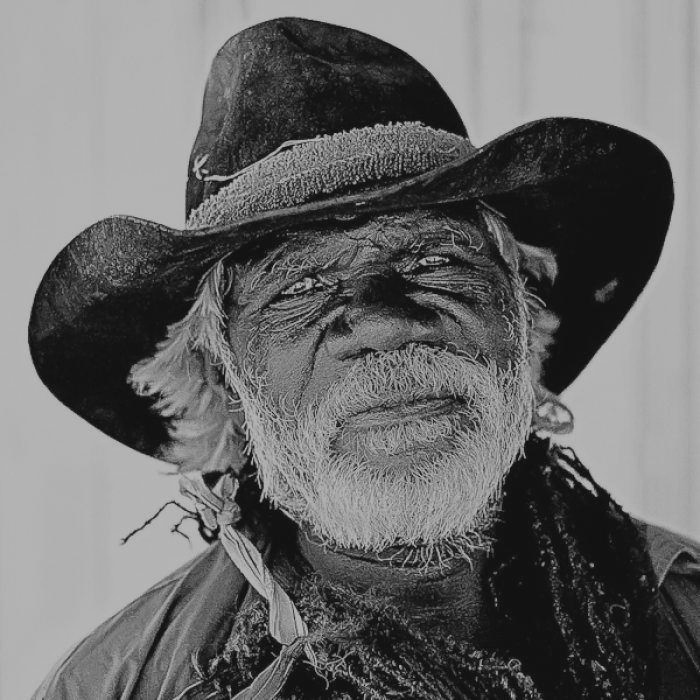
Top image - Rover Thomas | Bedford Station | 18050
Exciting First Showing of Rover Thomas Paintings
In this article, Japingka Gallery's David Wroth shares the story of finding some Rover Thomas paintings from a private art collection and how those works came to be offered for sale by Japingka Gallery.
Contact About Three Rover Thomas Paintings
The daughter of an art collector contacted us two years ago about a number of Rover Thomas paintings. They were painted on quite thin boards. She asked if we'd be interested in having a look at a group of artworks. We were very interested and flew over to visit the family and see the works. They are very exciting paintings, but they're also difficult works because they were painted on backing boards and needed considerable attention to display them well.
Rover Thomas Painting Style
Rover has this very loose, rapid approach to putting ochre paint on the surface and going back over the top of surfaces. It's a very intuitive, impulsive way of painting that gives the paintings their energy. There's a slightly unpolished quality to the finished work, where for example the dots are never perfect and symmetrical. Having said that, the dots even have their own energy as they outline the blocks of colour in the paintings.
Preparing The Paintings For Display
It's taken us a long time to get the paintings to a point where they're ready for display. The paintings now have meticulous cradles prepared for them to support the back of the materials, all of which are fitted with stainless steel fittings into a simple wooden frame.
The art restorer who worked around the edges of these paintings and prepared the frames has the legacy of having Rover's ochres that the artist worked with and the resin that he used. It was a very interesting process to see him match these materials from 35 years ago with the surfaces. He could look at the materials that the artist was using and see where he was using the standard materials that he always used and whether he'd picked up something that was a bit different to what he conventionally used. It was a wonderful thing that there was this selection of materials that Rover actually used in his paintings and the conservator could access those and make those adjustments and to prepare the edges where they'd been weathered over time.
When he looks at the materials that Rover used, he knows exactly whether it fits the normal type of Kimberley white ochre that he used, but also to assess those impulsive kinds of marks that are typical of the artist. So you get to know the signature style of the artist and when you're up close with a magnifying glass looking at the surface of the paintings, you can see which layers have gone over which sections and where the artist has maybe brushed loosely over an earlier set of marks. The restorer literally built his knowledge from the surface up, on all these paintings. We're grateful to have access to this incredible resource and to have that level of expertise. This conservator worked with Rover directly so he knows exactly what the materials are and exactly how the artist has approached the work.
On Display In The Gallery
At the moment we have hung the first two of these paintings near our front desk, and they're wonderful. The surfaces of them are gritty and fabulous, and people visit the gallery just to see them.
About Lingurr
I'm standing in front of a painting called Lingurr. I have to admit that at first, I was asking myself "Which way up does it go?" They're beautiful blocks of colour and out of the shapes of the background, there's the form of a snake. At first, I didn't see it because it could be part of the background that moves across the yellow space that looks like the hills and open spinifex country. It's one of those things that once you see it, it's quite obvious.
Having it here up on the gallery wall and you can look at it from a distance and have the luxury of just enjoying the surfaces and enjoying the composition. I have to admit it's a thrill having to look after this work and then see it to this point of presentation. It was more than worth the time and effort.
You can see a large black waterhole and the snake going across the country, a kind of classic Kimberley image of power coming out of a water hole. This really is beautiful work by Rover.
About Wati Kutjara
Another work we have is Wati Kutjara. This is the most simple of paintings. It's literally two deep umber coloured rectangles, outlined with white dots and a black border. A very simple painting and we were very happy to have it. It also has had a support cradle made for it. Now that its in a frame and we can put it up on the wall, we see that it shares that loose painting quality that is Rover's trademark. It has a level of spontaneity to it. This work is the story of the two Creation spirits, the two Wati Kutjara, the Creation Ancestor men. It's such a significant story that Rover talks about, the Dreaming track for this story goes right through the Kimberley and out to Broome.
His painting of Wati Kutjara represents two Ngarrankarni ceremonial sites linked to locations on that Dreaming track. That's Rover, it's incredibly simple, but it's very elegant and restrained. It's umber, black and white, that's all the colour in it. Yet it's iconic and representative of the hugeness of the story and the simplicity that Rover brings to a really big story when he puts it down in ochre.
Third Work Still To Come
These two paintings are hanging on the wall in front of us now, and we have another magnificent painting still having its final process done. So it's still being fitted to its frame and the cradle. That is also a gorgeous painting. It's all in earth tones, it has that sort of flowing movement that the Lingurr painting has. I'd describe it as brandy coloured. We're looking forward to having it here in the gallery in the next week or two.
The Best We've Seen In A Long Time
Even at this early stage, we've had inquiries about the paintings from the online site on Rover Thomas's artist page. There's been strong interest and people are coming into the gallery to have a look. There have been a few Rover Thomas works come up at auction recently, but we think these are some of the best that we've seen for a long time.
The Significance of Rover Thomas
This is an interesting time for artwork by Rover Thomas. He's always been recognised as one of the greats and one of the first major artists of the Indigenous fine art movement. He was one of the first Aboriginal artists to represent Australia at the Venice Biennial. You'll find his work's in every major gallery, including all the State galleries and the National Gallery. He's been widely celebrated, there've been books written about him. One of the main books on him was called I Love To Paint. That's really what it was because he would paint on anything. If he couldn't get his hands on canvas or a ready-prepared board, then he'd use a door or he'd use, in this case, some other plywood or board. He really wasn't choosy. He just wanted to paint.
Bringing Works To Public Attention
That has meant there's a large range of his artwork out there in the community still, probably that people haven't seen. There's no definitive catalogue saying, "These are all of Rover's paintings at the moment," because like these, there are works that have never been publicly exhibited. And yet, the person who did the conservation work on them believes them to be up there with some of his best works. We love them. I mean, they are crackers. I think it's a major find.
We're really proud to be able to show these to the public and bring them to the public's attention and add to Rover's large body of work. People are rediscovering what it is in Rover's work that makes them so compelling. I mean a great artist is always a great artist.
Less is More
I think his art continues to grow in popularity now because people love that sense of space in these paintings, that sense of less is more. It looks deceptively simple because it's so hard to create. You look at it and it speaks to your heart and that's what Rover's achieved. Rover does it effortlessly. It just works.
Rover Thomas Exhibitions
Exhibitions
Individual Exhibitions
1994 Roads Cross, The Paintings of Rover Thomas, National Gallery of Australia, Canberra.
1994 Rover Thomas, Utopia Art Sydney, Stanmore.
Group Exhibitions
1986 The Third National Aboriginal Art Award Exhibition, Museum and Art Gallery of the Northern Territory, Darwin.
1987 Aboriginal Art from the Kimberley, Goolarabooloo Gallery, Broome.
1987 Art of the East Kimberley, Birrukmarri Gallery, Perth.
1987 Recent Aboriginal Art from Western Australia, National Gallery of Australia, Canberra.
1988 ANCAAA and Boomalli, Boomalli Aboriginal Artists Co-operative, Sydney.
1988 Art from the Kimberley, Aboriginal Artists Gallery, Sydney.
1988 Innovative Aboriginal Art of Western Australia, University of Western Australia, Perth.
1988 Recent Aboriginal Painting, Art Gallery of South Australia, Adelaide.
1988 Creating Australia: 200 Years of Art 1788-1988, International Cultural Corporation of Australia, Touring.
1988 Australian Art Post-1960, Deutscher Gallery, Brunswick.
1989 On the Edge, five contemporary Aboriginal artists, AGWA, Perth.
1989 Turkey Creek: Recent Work, Deutscher Gertrude Street, Melbourne.
1989 A Myriad of Dreaming: Twentieth Century Aboriginal Art, Westpac Gallery, Melbourne; Design Warehouse Sydney [through Lauraine Diggins Fine Art].
1989 Masterpiece Fine Art Gallery, Hobart.
1989 l’ete Australien a’ Montpellier, Musee Fabre Gallery, Montpellier, France.
1990 Contemporary Aboriginal Art 1990: From Australia, Third Eye Centre, Glasgow and touring UK.
1990 Anatjari Tjampitjinpa, Dini Campbell Tjampitjinpa and Rover Thomas, John Weber Gallery, New York, USA.
1990 The Seventh National Aboriginal Art Award Exhibition, Museum and Art Gallery of the Northern Territory, Darwin.
1990 Venice Biennale: Australian Representative, with Trevor Nickolls.
1990 Adelaide Biennial of Australian Art, Art Gallery of South Australia.
1990 Balance 1990: views, visions, influences, Queensland Art Gallery, Brisbane.
1990 Contemporary Aboriginal Art from the Robert Holmes a Court Collection, Harvard University, University of Minnesota, Lake Oswego Center for the Arts, United States of America.
1990 L’ete Australian a Montpellier, Musee Fabre, France.
1990 Innovations in Aboriginal Art, Hogarth Galleries, Sydney.
1990 The Singing Earth, Chapman Gallery, Canberra.
1990 Abstraction, Art Gallery of New South Wales, Sydney.
1991 Aboriginal Art and Spirituality, High Court, Canberra.
1991 Flash Pictures, National Gallery of Australia.
1991 Walkabout in the Dreamtime, Virginia Miller Gallery, Miami, Florida, USA.
1992 Crossroads-Towards a New Reality, Aboriginal Art from Australia, National Museums of Modern Art, Kyoto and Tokyo.
1993 Trevor Nickolls and Paintings by Emily Kame Kngwarreye, Ginger Riley Manduwalawala and Rover Thomas, Hogarth Galleries, Sydney.
1993 The Tenth National Aboriginal Art Award Exhibition, Museum and Art Gallery of the Northern Territory, Darwin.
1993 Images of Power, Aboriginal Art of the Kimberley, National Gallery of Victoria, Melbourne.
1993/4 ARATJARA, Art of the First Australians, Touring: Kunstammlung Nordrhein-Westfalen, Dusseldorf; Hayward Gallery, London; LouisianaMuseum, Humlebaek, Denmark
1994 Power of the Land, Masterpieces of Aboriginal Art, National Gallery of Victoria.
1994 Identities: Art from Australia, Taipei Fine Arts Museum, Taiwan, Wollongong City Gallery.
1994 Australian Heritage Commission National Aboriginal and Torres Strait Islander Art Award Exhibition, Old Parliament House, Canberra.
1994 This Land: A Celebration, Utopia Art Sydney, Stanmore.
1994 Yiribana, Art Gallery of New South Wales, Sydney.
1995 Stories, Eine Reise zu den grossen Dingen, touring, Sprengel Museum Hannover, Museum fur Volkerkunde Leipzig, Haus der Kulteren der Welt Berlin, Ludwig-Forum fur Internationale Kunst Aachen.
1995 The Twelfth National Aboriginal Art Award, Museum and Art Gallery of the Northern Territory, Darwin 1994 Rover Thomas: An Artist from Turkey Creek, Hogarth Galleries Sydney.
1994 This land: A Celebration Utopia Art, Sydney.
1994 Power of the Land: Masterpieces of Aboriginal Art, National Gallery of Victoria, Melbourne.
1994 Roads Cross -The Paintings of Rover Thomas, National Gallery of Australia.
1994 Rover Thomas New Paintings, Utopia Art, Sydney.
1995 Rover Thomas -Well 33 Revisited, William Mora Galleries, Melbourne.
1995 Painting up the Country: Aboriginal art from the Kimberley WA, Cooee Aboriginal art, Sydney.
1995 The Festival of Darwin Art exhibition: Kimberley Printmakers.
1995 Offset and Intaglio. Fremantle Arts Centre, Fremantle.
1995 Made in the Kimberleys, Moores Building Fremantle.
1995 Northwest and Kimberley Artists, Durack Gallery, Kimberley Fine Art, Broome.
1995 Latest Landscapes, Utopia Art, Sydney.
1995 12th NATSI Art Award Museum & Art Gallery of NT, Darwin.
1995 Stories: Eine Reise zu den Grossen Dingen – Elf Kunstler der australischen Aborigines. Werke aus der sammlung Holmes a Court, Perth – Sprengel Museum,Hannover-Museum fur Volkerkunde zu leipzig – Haus der Kulturen der Welt, berlin – Ludwig Forum fur internationale Kunstt, Aachen.
1996 Figures in the Land, National Gallery of Victoria, Melbourne.
1996 Abstraction: Signs, Marks, Symbols National Gallery of Victoria Melbourne.
1996 ‘This is my country, this is me’ Seattle art museum,Seattle USA.
1996 Contemporary Australian Abstraction, Niagara Galleries Melbourne.
1996 Flagging the Republic, Sherman galleries, New England regional Gallery, Touring.
1996 Nangara: The Australian Aboriginal Art exhibition-Ebes Collection Sichting Sint-Jan, Brugges, Belgium.
1996 Abstraction: Signs, Marks, Symbols National Gallery of Victoria Melbourne.
1996 ‘This is my country, this is me’ Seattle art museum ,Seattle USA.
1996 Contemporary Australian Abstraction, Niagara Galleries Melbourne.
1996 Flagging the Republic, Sherman galleries, New England regional Gallery, Touring.
1996 Nangara: The Australian Aboriginal Art exhibition-Ebes Collection Sichting Sint-Jan, Brugges, Belgium.
1997 Contemporary Australian Aboriginal Paintings, Songlines Aboriginal Art Gallery, Amsterdam, San Francisco.
1997 Imaging the Land National Gallery of Victoria, Melbourne.
1999 Myer Gatner Collection USA.
2000 From Appropriation to Appreciation: Indigenous influences and images in Australian Visual Art. Flinders University Art Museum Adelaide.
2000 Images of the Land, Art Gallery of NSW Sydney.
2013 Landmarks and Law Grounds, Japingka Gallery, Fremantle
2014 Kimberley Ochre Artists, Japingka Gallery, Fremantle
2016 Ochre Painters of The Kimberley, Japingka Gallery, Fremantle
2017 Made In Ochre - Kimberley Artists, Japingka Gallery, Fremantle
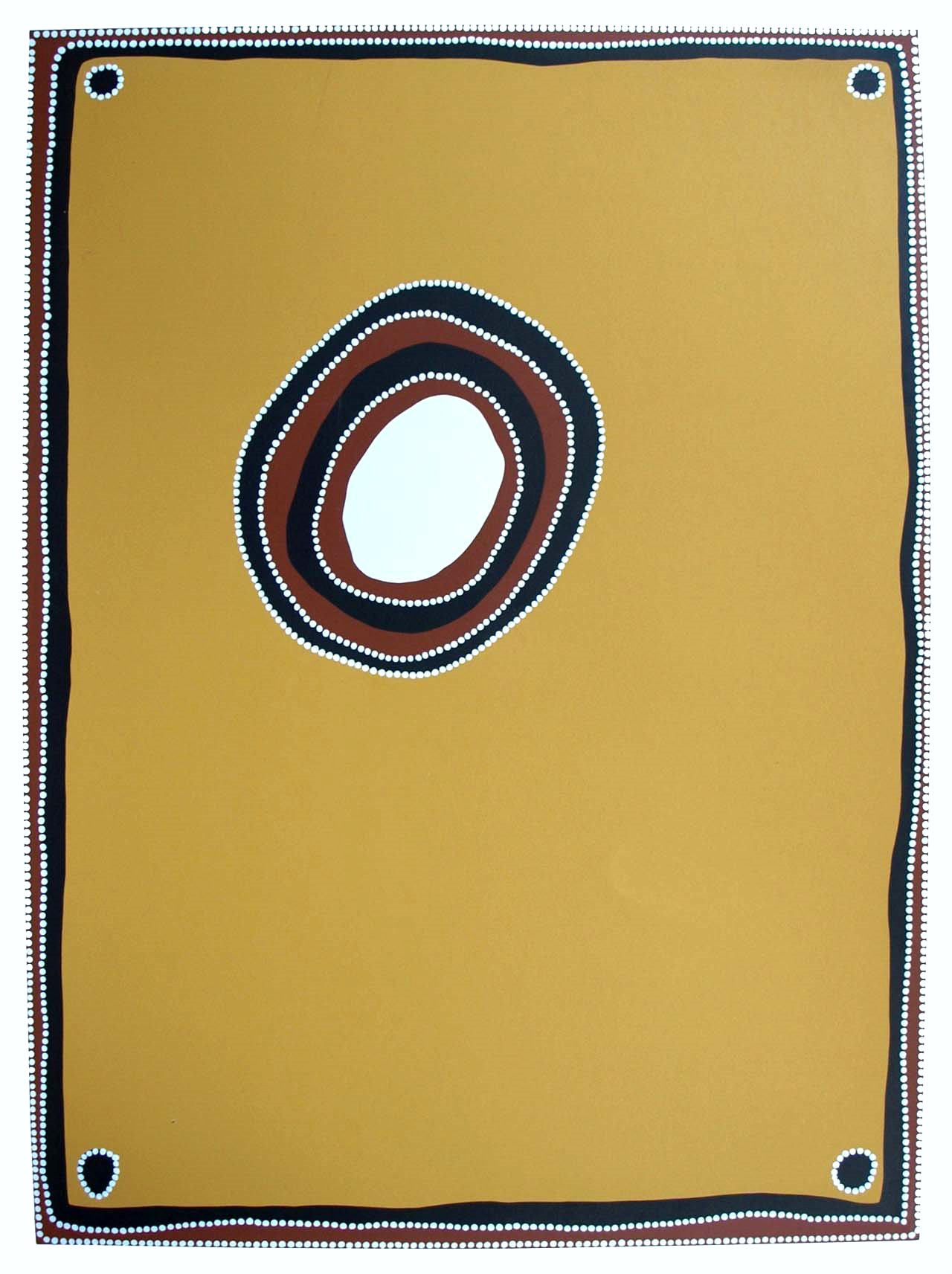
Subscribe To Our Email Newsletter
Receive notifications and news about exhibitions and artists.
Related Materials
Achievements
1990 John McCaughey Prize, Art Gallery of New South Wales
1990 Venice Biennale
1994 Roads Cross: The Paintings of Rover Thomas, National Gallery of Australia

